Lacerta is a small constellation in the northern sky. It represents the lizard. It is a faint constellation that lies in the rich field of the Milky Way’s bright band, in the region between the brighter constellations of Andromeda, Cassiopeia, Pegasus, and Cygnus.
Lacerta is sometimes called Little Cassiopeia because its brightest stars form a “W” pattern, just like the bright stars of the larger Cassiopeia.
Lacerta is not one of the 48 ancient constellations catalogued by Ptolemy and it is not associated with any myths. It was created by the Polish astronomer Johannes Hevelius in 1687.
The brightest stars in Lacerta shine at fourth magnitude and they do not stand out in the sky. Notable stars in the constellation include the nearby red dwarf EV Lacertae, the variable red supergiant V424 Lacertae, the massive blue star 10 Lacertae, and Babcock’s Magnetic Star (HD 215441).
The Lizard constellation hosts several relatively bright open clusters, including NGC 7243 (Caldwell 16), NGC 7209, and NGC 7296. It is also home to the Great Lacerta Nebula, a large but faint emission nebula ionized by 10 Lacertae, and BL Lacertae, a blazar that serves as the prototype for a class of deep sky objects known as the BL Lacertae objects.
Facts, location and map
Lacerta is the 68th constellation in size, occupying an area of 201 square degrees of the northern sky. It is located in the fourth quadrant of the northern hemisphere (NQ4). The entire constellation can be seen from locations between the latitudes +90° and -40°. The neighboring constellations are Andromeda, Cassiopeia, Cepheus, Cygnus and Pegasus.
The constellation name Lacerta is pronounced /ləˈsɜːrtə/. It is the Latin word for “lizard.” In English, the constellation is known as the Lizard. The genitive form of Lacerta, used in star names, is Lacertae (pronunciation: /ləˈsɜːrtiː/). The three-letter abbreviation, adopted by the International Astronomical Union (IAU) in 1922, is Lac.
The constellation of Lacerta belongs to the Perseus family of constellations, along with Andromeda, Auriga, Cassiopeia, Cepheus, Cetus, Pegasus, Perseus and Triangulum.
Lacerta hosts 12 stars with known planets. The brightest star in the constellation is Stellio (Alpha Lacertae), with an apparent magnitude of 3.76.
Lacerta contains three stars with formal proper names. The star names approved by the International Astronomical Union (IAU) are Stellio (Alpha Lacertae), Taika (HAT-P-40), and Tengshe (V484 Lacertae).
Lacerta does not contain any Messier objects. There are no meteor showers associated with the constellation.
The best time of the year to see Lacerta is during the month of October, when the constellation appears higher in the sky at 9 pm.
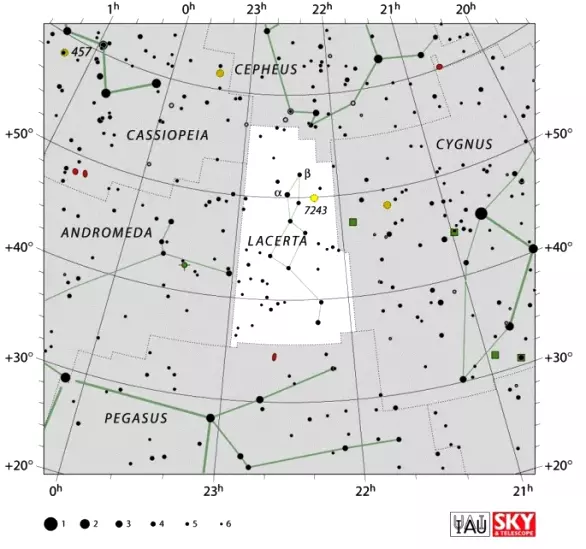
Lacerta constellation map by IAU and Sky & Telescope magazine (Roger Sinnott & Rick Fienberg) (CC BY 3.0)
Story
The Polish astronomer Johannes Hevelius introduced the constellation Lacerta in his star atlas Firmamentum Sobiescianum, sive Uranographia, published in 1687. Hevelius named the constellation Stellio, after the starred agama (Laudakia stellio), a type of lizard with star-like spots, also known as the stellion. However, the name Stellio was not widely used and it fell into oblivion.
Hevelius introduced six other constellations: Canes Venatici (the Hunting Dogs), Leo Minor (the Lesser Lion), Lynx (the Lynx), Scutum (the Shield), Sextans (the Sextant), and Vulpecula (the Fox).
The English astronomer John Flamsteed added several stars to Lacerta that Hevelius had assigned to the constellation Cepheus (the King). These stars – Alpha, Beta, and 9 Lacertae – were later depicted as part of the Lizard’s head.
The name Lacerta does not come from mythology. Ancient observers did not regard the faint stars in this region of the sky as a constellation.
Some of Lacerta stars were included in the obsolete constellations Sceptrum et Manus Iustitiae (the Sceptre and Hand of Justice) and Honores Friderici (Frederick’s Honours).
Sceptrum et Manus Iustitiae was created by the French architect Augustin Royer in honour of the French King Louis XIV in 1679, and Honores Friderici (Gloria Friderici) was defined by the German astronomer Johann Bode to honour the Prussian King Frederick the Great in 1787. The two constellations fell into disuse, while Lacerta became one of the modern 88 constellations when the constellation boundaries were defined in the early 20th century.
Lacerta stars
The stars of Lacerta are relatively inconspicuous in the night sky. The constellation’s five main stars – Alpha, Beta, 2, 4, and 5 Lacertae – form a zig-zag pattern that looks like a fainter miniature version of Cassiopeia’s W. The asterism has earned Lacerta the nickname Little Cassiopeia. It can be seen in clear, dark skies in the region between Cassiopeia and Cygnus.
Alpha Lacertae, the brightest star in Lacerta, shines at magnitude 3.76. It is the only star in the constellation that is brighter than magnitude 4.0.
Many visible stars in Lacerta are members of the Lacerta OB1 association. The stellar association contains many exceptionally hot and luminous stars that lie at great distances. These stars are visible to the unaided eye because they are tens of thousands of times more intrinsically luminous than the Sun.
Stellio – α Lacertae (Alpha Lacertae)
Alpha Lacertae (α Lac) is a main sequence star of the spectral type A1 V. With an apparent visual magnitude of 3.76, it is the brightest star in Lacerta. It lies 102.6 light-years from the solar system.
The star has a mass 2.194 times that of the Sun and a radius of 2.1432 solar radii. With an effective temperature of 9,050 K, it shines with 27.6750 solar luminosities.
Alpha Lacertae is a fast spinner, with a projected rotational velocity of 128 km/s. It has an estimated age of 400 million years.
The star has a visual, line-of-sight companion with an apparent magnitude of 11.8. The companion, catalogued as CCDM J22313+5017B, is also an A-type star. It appears about 36 arcseconds from Alpha Lacertae.
In 2024, the International Astronomical Union (IAU) approved the name Stellio for Alpha Lacertae. Stellio was the alternative name for the constellation Lacerta used by Johannes Hevelius in his catalogue and star atlas. The word stellio means “star lizard.”
1 Lacertae
1 Lacertae (1 Lac) is an orange giant or bright giant of the spectral type K3 II-III. It is located approximately 680 light-years away. With an apparent magnitude of 4.15, it is the second brightest star in Lacerta.
The evolved star has a mass of 4.16 solar masses and has expanded to a size of 69.01 solar radii as it evolved away from the main sequence. With an effective temperature of 4,288 K, it shines with a luminosity of 1,453 Suns. The star spins at 10 km/s. It has an estimated age of only 170 million years.
5 Lacertae
5 Lacertae (5 Lac) is a spectroscopic binary system located 2,170 light-years away. It has an apparent magnitude of 4.36 and is the third brightest star in Lacerta. The system is composed of a giant or supergiant of the spectral type K6-M0I and a hot blue main sequence star with the stellar classification B7/8V. The stars have an orbital period of just under 42 years.
5 Lacertae is classified as a slow irregular variable (type LC). Its brightness has been observed to vary between magnitudes 4.39 and 4.56 without a clearly defined period. The star has the variable star designation V412 Lacertae.
The primary component in the system has 5.11 times the Sun’s mass and a radius of 359 solar radii. With a surface temperature of 3,790 K, it shines with 25,100 solar luminosities. The star spins at 50 km/s. It has an estimated age of 110 million years.
The companion is an even faster spinner, with a projected rotational velocity of 89 km/s.
β Lacertae (Beta Lacertae)
Beta Lacertae (β Lac) is a yellow giant star of the spectral type G8 III. It shines at magnitude 4.43 from a distance of 170 light-years. Even though it has the Bayer designation Beta, it is only the fourth brightest star in Lacerta. In terms of evolution, the star is a red clump giant. It has undergone a helium flash and is now fusing helium in its core.
The star has 97% of the Sun’s mass and has expanded to a size of 10.96 solar radii as it evolved away from the main sequence. It is 57.7 times more luminous than the Sun and has a surface temperature of 4,803 K. It is believed to be around 6.76 billion years old.
Beta Lacertae may be the primary component in a binary star system. The suspected companion appears at a separation of only 0.2 arcseconds.
HD 211073
HD 211073 is a triple star system located approximately 580 light-years away. It shines at magnitude 4.50.
The primary component in the system is an orange giant of the spectral type K2.5 III. It has an estimated age of 1 billion years. The star is classified as a suspected variable star. Its brightness varies from magnitude 4.49 to 4.55.
The evolved star has 2.23 times the Sun’s mass and a radius 45.69 times that of the Sun. It is 573.50 times more luminous than the Sun with an effective temperature of 4,180 K. It spins at 2.9 km/s.
The primary star has a close companion at an angular separation of 0.20 arcseconds and a more distant companion at a separation of 0.30 arcseconds.
11 Lacertae
11 Lacertae (11 Lac) is an orange giant of the spectral type K2.5 III, located around 350 light-years away. It has an apparent magnitude of 4.46.
The star has a mass of 1.38 solar masses and a radius 29.5 times that of the Sun. With an effective temperature of 4,352 K, it shines with 279 solar luminosities. The star has an estimated age of 3.2 billion years.
6 Lacertae
6 Lacertae (6 Lac) is a single-lined spectroscopic binary star located approximately 1,900 light-years away. The presence of the unseen companion can only be deduced based on the primary component’s spectrum shift towards the blue and then towards the red, indicating that it is moving towards us and away from us, i.e. orbiting around a common centre of mass. The two components have an orbital period of 880 days.
The primary star is a young luminous blue subgiant star of the spectral type B2 IV. It has an estimated age of only 15.7 million years. The star is a suspected member of the Lacerta OB1 association.
6 Lacertae has a mass 12.5 times that of the Sun and a radius of 6.9 solar radii. With a surface temperature of 21,150 K, it is 34,590 times more luminous than the Sun. The star is a fast spinner, with a projected rotational velocity of 70 km/s.
2 Lacertae
2 Lacertae (2 Lac) is a double-lined spectroscopic binary star located 550 light-years away. It is composed of two massive blue stars of the spectral types B6IV and B6V. The two components cannot be resolved even in the largest of telescopes, but the binary nature of the system can be inferred from periodic shifts in the system’s spectrum. The stars have an orbital period of 2.616439 days.
The primary component is the more evolved of the two. It has almost burned through the hydrogen in its core and will soon evolve away from the main sequence. It has a mass 6.99 times that of the Sun and an effective temperature of 15,000 K. It spins at 50 km/s.
The secondary star has a mass of 5.55 solar masses and spins at 35 km/s.
The 2 Lacertae star system is classified as a suspected rotating ellipsoidal variable. Its brightness varies from magnitude 4.53 to 4.56.
Rotating ellipsoidal variables are close binary systems in which the two components are highly distorted by mutual gravitational forces and not spherical in shape. Their orbital plane is not aligned to our line of sight so that the components eclipse each other, but so that we see different parts of the stars’ surfaces as the stars orbit around each other.
4 Lacertae
4 Lacertae (4 Lac) is a hot blue supergiant of the spectral type A0 Ib. With an apparent magnitude of 4.55, the star is visible to the unaided eye even though it lies approximately 2,600 light years away. It is a suspected member of Lacerta OB1.
The supergiant is thought to be a blue loop star, an evolved star that has already spent time as a red supergiant after evolving away from the main sequence.
4 Lacertae has 19 times the Sun’s mass, which seals its fate as a supernova in the not-so-distant future (astronomically speaking). It has a radius 59 times that of the Sun and is 62,000 times more luminous than the Sun. It has a surface temperature of 11,800 K.
The star spins at 28 km/s. It has an estimated age of only 25.1 million years.
10 Lacertae
10 Lacertae (10 Lac) is a hot blue main sequence star of the spectral type O9V. It has an apparent magnitude of 4.88 and lies approximately 1,800 light-years away. It has an estimated age of only 3.55 million years. It is a member of the Lacerta OB1 association.
The star has a mass of 21.6 solar masses and a radius 7.4 times that of the Sun. With an effective temperature of 34,550 K, it is 69,200 times more luminous than the Sun. It spins at 14 km/s.
Even though it is still a very young star, 10 Lacertae has evolved quickly due to its high mass. It will not be long before it goes out as a spectacular supernova.
Observations with the MIRI instrument on the James Webb Space Telescope (JWST) in 2024 yielded a mass loss rate of 2 − 4 × 10−8 M⊙ yr−1 for the star.
10 Lacertae is used as a spectral standard for its class in the Morgan-Keenan-Kellman (MKK) spectral classification system. It was one of the first O-type stars to be selected as an anchor point used to classify other stars, along with the massive S Monocerotis, the brightest star in the Christmas Tree Cluster (NGC 2264) in the constellation Monoceros (the Unicorn).
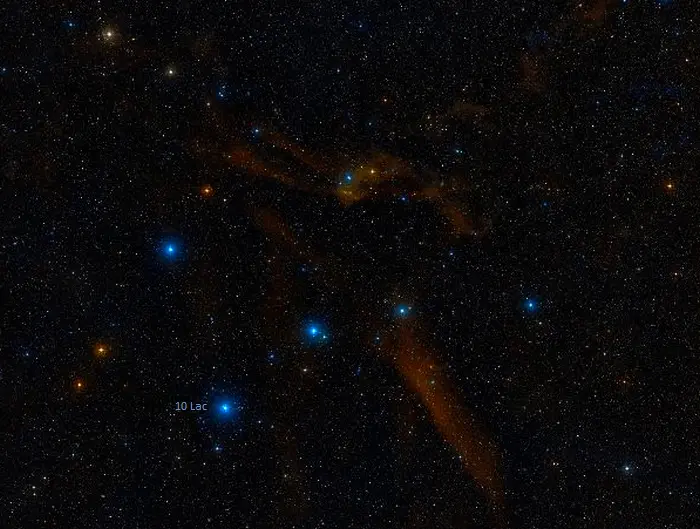
10 Lacertae and the Great Lacerta Nebula, image: Wikisky (DSS2)
Tengshe – V424 Lacertae
V424 Lacertae (V424 Lac) is a variable red supergiant located 2,300 light-years away. It is one of the brighter members of the Lacerta OB1 association. It has an apparent magnitude of 4.94.
The supergiant star has the stellar classification K5 Ib. It has a mass 6.8 times that of the Sun and a radius of 288 solar radii. With a surface temperature of 3,749 K, it shines with 16,600 solar luminosities.
V424 Lacertae is classified as a slow irregular variable. Its brightness varies with multiple short periods, and the star exhibits slow variations with a period of 1,100 or 1,601 days.
The star shows an ultraviolet excess, which may indicate an invisible companion. In 2014, astronomers proposed that it has a sub-stellar companion orbiting the star with a period of 1,382 days at a distance of 6.2 astronomical units (AU).
In 2024, the International Astronomical Union (IAU) formally named the star Tengshe. Tengshe (Téng Shé) is the name of an ancient Chinese constellation dating back to the 2nd century BCE. It means “the Flying Serpent.”
EV Lacertae
EV Lacertae (EV Lac) is a red dwarf star located only 16.476 light-years away. With an apparent magnitude of 10.26, it is invisible to the unaided eye but can be seen in small telescopes. It is catalogued as Gliese 873 (GJ 873) in the Gliese Catalogue of Nearby Stars.
EV Lacertae has the stellar classification M3.5 or M4.0Ve. It has a mass of 0.32 solar masses and a radius of 0.331 solar radii. It has a surface temperature of 3,370 K. With a projected rotational velocity of 4.5 km/s, the star takes 4.3715 days to complete a rotation. It has an estimated age of 300 million years.
EV Lacertae is a flare star that emits X-rays. The brightest flare from the star was detected by NASA’s Swift satellite on April 25, 2008. Even though the star is much smaller than the Sun, the flare was thousands of times more powerful than the largest recorded flare coming from the Sun. It was the brightest flare detected from a star other than the Sun.
EV Lacertae is a fast spinner. Combined with its convective interior, the fast spin rate creates a strong magnetic field, which is partly responsible for such bright flares.
On December 31, 2023, astronomers detected another large stellar flare. After both large flares, the star appeared blue.
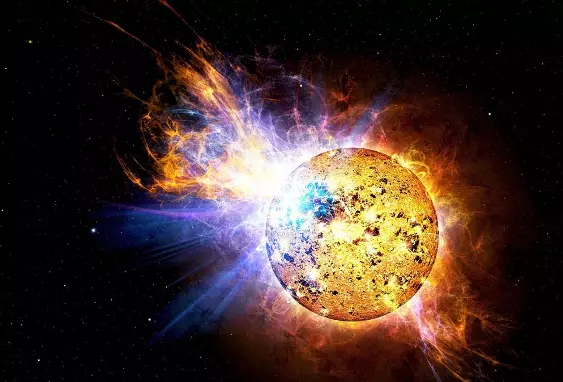
Featured image of NASA. On April 25, 2008, NASA’s Swift satellite picked up a record-setting flare from a star known as EV Lacertae. This flare was thousands of times more powerful than the greatest observed solar flare. But because EV Lacertae is much farther from Earth than the Sun, the flare did not appear as bright as a solar flare. Still, it was the brightest flare ever seen from a star other than the Sun. What makes the flare particularly interesting is the star. EV Lacertae is much smaller and dimmer than our sun. In other words, a tiny, wimpy star is capable of packing a very powerful punch. How can such a small star produce such a powerful flare? The answer can be found in EV Lacertae’s youth. Whereas our Sun is a middle-aged star, EV Lacertae is a toddler. The star is much younger than our Sun, and is still spinning rapidly. The fast spin, together with its churning interior, whips up gases to produce a magnetic field that is much more powerful than the Sun’s magnetic field. Image: Casey Reed/NASA (PD)
Taika (HAT-P-40)
HAT-P-40 is an F-type star located approximately 1,515 light years away. It has an estimated age of 2.70 billion years. It shines at magnitude 11.7, well below unaided eye visibility.
HAT-P-40 has a radius about twice that of the Sun. The mass estimates for the star are in the range from 1.03 to 1.5 solar masses.
The star hosts an orbiting planet, a gas giant with a radius 1.52 times that of Jupiter and a mass of 0.48 Jupiter masses. The planet was discovered in 2012. It orbits the star with a period of 4.5 days at a distance of only 0.0608 astronomical units (AU), or 6% of the distance between the Earth and the Sun.
HAT-P-40 was formally named Taika during the International Astronomical Union’s 2019 NameExoWorlds campaign. Taika is the Lithuanian word for “peace.” The orbiting exoplanet, HAT-P-40 b, was named Vytis, after the symbol for the Lithuanian coat of arms.
U Lacertae
U Lacertae is a spectroscopic binary star system located approximately 8,969 light-years away. It has an apparent magnitude of 9.40. The primary component in the system is one of the largest stars known.
The star system is composed of a red supergiant of the spectral type M4epIab and a B-type companion. The primary component has a mass 22 times that of the Sun and a radius 1,013 times the Sun’s. It has a surface temperature of 3,535 K and is 152,000 times more luminous than the Sun.
U Lacertae is classified as a semiregular variable star (type SRc). Its brightness varies with a main period of 150 days.
U Lacertae is a member of the Cepheus OB1 association, a stellar association found around the Wizard Nebula and the open cluster NGC 7380 in the constellation Cepheus. The member stars are mostly massive, luminous, blue O- and B-type stars, but the brightest members are cool supergiant and hypergiant stars. They include the yellow hypergiant V509 Cassiopeiae in Cassiopeia and orange hypergiant RW Cephei in Cepheus.
HD 216536
HD 216536 is a K-type star located 1,227 light-years away. It has a mass similar to the Sun and a radius 9-12 times the Sun’s. It is believed to be around 4 billion years old. With an apparent magnitude of 9.23, the star is invisible to the unaided eye.
HD 216536 hosts a gas giant planet with a mass of 1.05 Jupiter masses and a radius 1.23 times that of Jupiter. The planet has an orbital period of 148.6 days and an orbital distance of 0.61 astronomical units. It was discovered in 2015.
DI Lacertae
DI Lacertae (DI Lac) was a nova discovered by the British astronomer Thomas Henry Espinell Compton Espin on December 30, 1910. At the time of discovery, it shone at eighth magnitude.
The outburst occurred in November 1910 and the nova event peaked at magnitude 4.6 on November 26, when it was visible to the unaided eye. It is considered a “fast nova.” After reaching its peak brightness, it faded by 3 magnitudes in 43 days.
Before the outburst, DI Lacertae was a 14th magnitude star. It returned to its usual brightness by 1950.
Novae occur in binary systems in which one of the components is a white dwarf that accretes matter from its close companion. As the material is heated, it reaches a temperature at which it ignites, triggering a runaway fusion that causes the atmosphere to be expelled into space.
The white dwarf in the DI Lacertae system has a mass of 0.91 solar masses. The two components have an orbital period of 13.050 hours.
DI Lacertae is also known as Nova Lacertae 1910.
AR Lacertae
AR Lacertae is a triple star system composed of two subgiant stars and a white dwarf. The system lies 138.6 light-years away and has an apparent magnitude of 6.080. It serves as the prototype for a class of detached binary systems that vary in brightness.
The AR Lacertae system is classified as an Algol-type eclipsing variable, as well as an RS Canum Venaticorum variable. The two brighter components form a spectroscopic binary system with an orbital period of only 1.98 days. They orbit each other at a separation of only 8.869 solar radii. Like Algol, the system varies in brightness because the components eclipse each other during their orbit.
Like all RS CVn variables, the brighter components form a close binary system. They have active chromospheres and large stellar spots that cause the system’s brightness to vary. The components’ rotation periods are tidally locked to their orbital period. Both components have star spots and show an activity cycle of around 17 years.
The primary component is an orange subgiant of the spectral type K0IVe and the secondary is a yellow subgiant with the stellar classification of G2IV. The orange subgiant has a mass of 1.21 solar masses and a radius 2.61 times that of the Sun. It is 3.55 times more luminous than the Sun, with an effective temperature of 5,100 K.
The secondary component, the yellow subgiant, has a mass of 1.17 solar masses and a radius of 1.51 solar radii. It shines with 2.09 times the Sun’s luminosity and has a surface temperature of 5,826 K.
The third component in the system, a white dwarf, was discovered in 2022. It is separated by 21.9 arcseconds from the main pair, corresponding to a physical separation of around 930 astronomical units (Earth – Sun distances). It is catalogued as WDJ220838.73+454434.04.
The white dwarf has a mass about 60% that of the Sun and a radius of 0.0125 solar radii. It has an estimated age of 5.75 billion years. It takes about 16,000 years to complete an orbit around the binary pair.
The AR Lacertae system is a radio source and also emits X-rays. It was identified as an X-ray source in 1987 during observations with the European X-ray Observatory Satellite (EXOSAT).
Babcock’s Star
Babcock’s Star (HD 215441), or Babcock’s Magnetic Star, is a variable star that lies approximately 5,100 light-years away. It has the variable star designation GL Lacertae. With an apparent magnitude of 8.81, the star is invisible to the unaided eye.
HD 215441 is a chemically peculiar star with a mass of about 3.9 solar masses and a surface temperature of 14,500 K. Most sources classify it as a silicon-rich B-type star.
The star was named after the American astronomer Horace W. Babcock, who discovered that it has a very strong magnetic field (about 34 kilogauss) in 1959. At the time, it had the strongest magnetic field of all known main sequence stars. Unlike most magnetic stars, Babcock’s Star is a relatively slow rotator, with a rotational period of 9.4871 days.
Babcock’s Star is classified as an Alpha2 Canum Venaticorum variable. Like the class prototype Cor Caroli (Alpha2 Canum Venaticorum) in the constellation Canes Venatici, Alpha2 CVn stars are hot, chemically peculiar stars with strong magnetic fields and strong spectral lines of silicon, strontium or chromium. Their brightness varies with a period that corresponds to their rotation period because the uneven distribution of metals in their atmospheres causes different parts of their surfaces to vary in brightness.
Roe 47
Roe 47 (HD 213660) is a star system consisting of five components with apparent magnitudes of 5.8, 9.8, 10.1, 9.4, and 9.8. The system has the stellar classification A6V, indicating a white main sequence star as the primary component.
ADS 16402
ADS 16402 is a double star located approximately 523 light-years away. The binary star system is composed of stars of the spectral types F8 and G0V. Both components are too faint to be visible to the unaided eye. They have apparent magnitudes of 10 and 10.4. The star system has an estimated age of about 1.9 billion years.
ADS 16402 A and ADS 16402 B (HAT-P-1) are separated by 1,500 astronomical units (AU), corresponding to an angular separation of 11.26 arcseconds in the sky. The system was discovered to be a binary star by the British astronomer John Herschel in 1831.
Both stars in the system have similar stellar parameters to the Sun. ADS 16402 A has a mass of 1.16 solar masses and a radius of 1.123 solar radii. It has a surface temperature of 6,251 K and shines with 1.82 solar luminosities.
ADS 16402 B has a mass of 1.151 solar masses and a radius 1.174 times that of the Sun. With an effective temperature of 6,049 K, it is 1.585 times more luminous than the Sun.
In September 2006, a planet was discovered orbiting the secondary component. It was the first of the 164 planets discovered by the Hungarian Automated Telescope Network (HATNet) project. The planet was catalogued as HAT-P-1b and its host star as HAT-P-1.
HAT-P-1b is one of the least dense extrasolar planets discovered to date. It is a hot Jupiter with a mass of 0.529 Jupiter masses and a mean radius of 1.319 Jupiter radii. The gas giant takes 4.4652968 days to complete an orbit around its parent star at a distance of only 0.05561 astronomical units (5.561% of the Earth’s orbital distance).
Deep sky objects in Lacerta
Lacerta does not contain any particularly bright deep sky objects. It hosts a single object listed in the Caldwell catalogue, the open cluster NGC 7243 (Caldwell 16).
NGC 7243 is one of three deep sky objects in Lacerta that are included in the Herschel 400 catalogue of objects that can be observed in amateur telescopes. The other two objects on the Herschel 400 observing list are the open clusters NGC 7209 and NGC 7296.
NGC 7243 (Caldwell 16)
NGC 7243 is an open star cluster located approximately 2,800 light-years away in Lacerta. It has an apparent magnitude of 6.4 and an apparent size of 21 arcminutes. It is catalogued as Caldwell 16 in Patrick Moore’s Caldwell catalogue.
NGC 7243 has an estimated age of just over 100 million years. It was discovered by the German-born British astronomer Sir William Herschel on September 26, 1788. It is easily observed in small telescopes.
The cluster appears near Alpha Lacertae and 4 Lacertae in the sky. The planetary nebula IC 5217 appears in the same region.
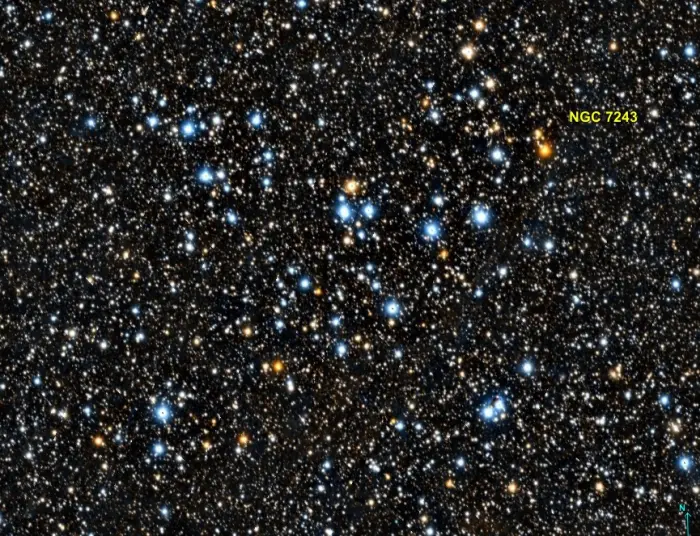
NGC 7243, image created using the Aladin Sky Atlas software from the Strasbourg Astronomical Data Center and Pan-STARRS (Panoramic Survey Telescope And Rapid Response System) public data. Credit: Donald Pelletier (CC0 1.0)
BL Lacertae
BL Lacertae (BL Lac) is a variable extragalactic active galactic nucleus (AGN) located 0.9 billion light-years away in Lacerta. Its apparent magnitude varies between magnitude 14 and 17 over short periods.
BL Lacertae is a type of blazar, an AGN with a jet of ionized matter moving at nearly the speed of light and directed almost exactly towards an observer. The jet of plasma is thought to be ejected from the vicinity of a supermassive black hole.
BL Lacertae is the prototype for a class of highly variable objects known as the BL Lacertae objects. These are believed to be intrinsically low-power radio galaxies with relativistic jets closely aligned to our line of sight.
BL Lacertae was discovered by the German astronomer Cuno Hoffmeister in 1929. At the time, it was believed to be a variable star and given the variable star designation BL Lacertae. It was identified as a bright, variable radio source by John Schmitt at the David Dunlap Observatory in Ontario, Canada, in 1968. Schmitt also reported a trace of a host galaxy.
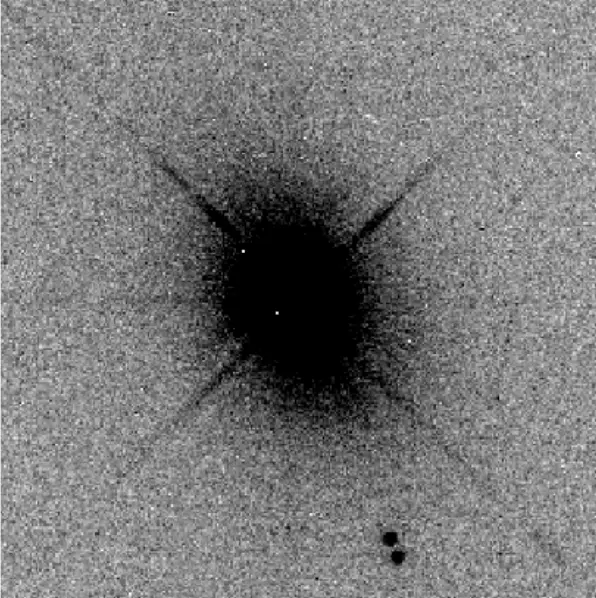
Image of BL Lacertae obtained by the Hubble Space Telescope (HST). Credit: NASA/ESA & Hubble (CC0 1.0)
NGC 7209
NGC 7209 is an open star cluster located 3,810 light-years away. It has an apparent visual magnitude of 7.7 and an apparent size of 25 arcminutes. It was discovered by Sir William Herschel on October 19, 1787. The cluster appears in the same region of the sky as the Cocoon Nebula (IC 5146) in the constellation Cygnus (the Swan).
NGC 7209 has a tidal radius of 30 light years. It contains around 150 stars that shine at magnitude 9 to 15. It has a mass of 278 solar masses and an estimated age of 420 million years.
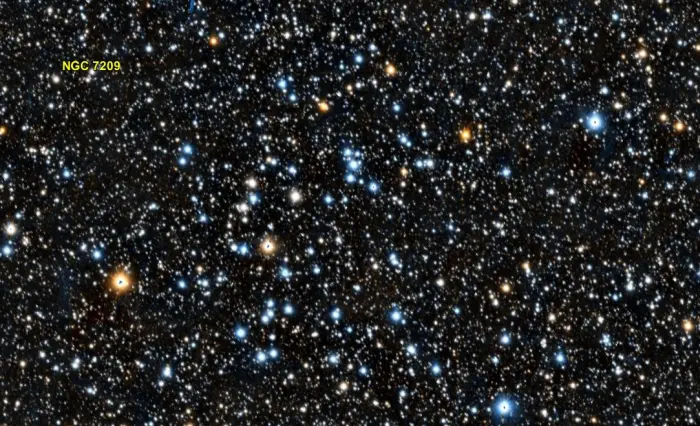
NGC 7209, image created using the Aladin Sky Atlas software from the Strasbourg Astronomical Data Center and Pan-STARRS (Panoramic Survey Telescope And Rapid Response System) public data. Credit: Donald Pelletier (CC0 1.0)
NGC 7197
NGC 7197 is a spiral galaxy with an apparent magnitude of 12.8. It lies approximately 190 million light years away. It was discovered by William Herschel on October 17, 1786.
The galaxy has an angular size of 1.95 by 0.9 arcminutes, corresponding to a physical diameter of 105,000 – 110,000 light-years.
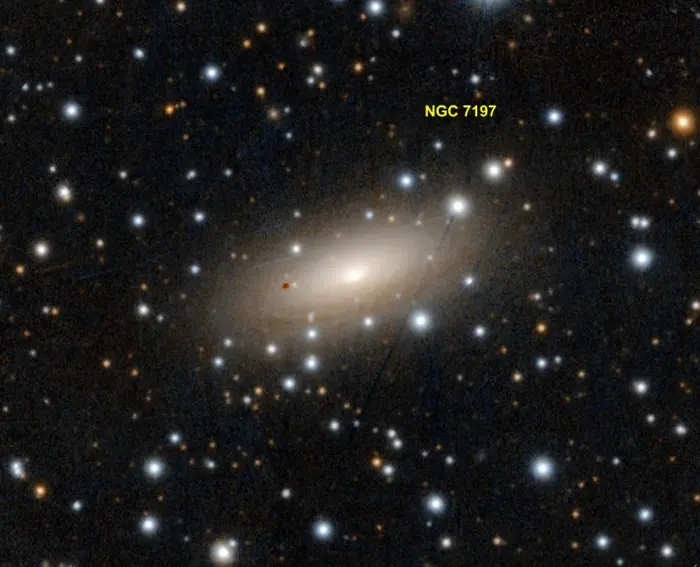
NGC 7197, image created using the Aladin Sky Atlas software from the Strasbourg Astronomical Data Center and Pan-STARRS (Panoramic Survey Telescope And Rapid Response System) public data. Credit: Donald Pelletier (CC0 1.0)
NGC 7250
NGC 7250 is an irregular galaxy located 49.99 million light-years away in Lacerta. It has an apparent magnitude of 12.58. It was discovered by William Herschel on November 8, 1790.
The galaxy has a high rate of star formation. It hosted a supernova, SN 2013dy, discovered in 2013. SN 2013dy was classified as a type Ia supernova. At the time of discovery, it was the fastest discovered supernova known. It was detected only 2.4 hours after the outburst.
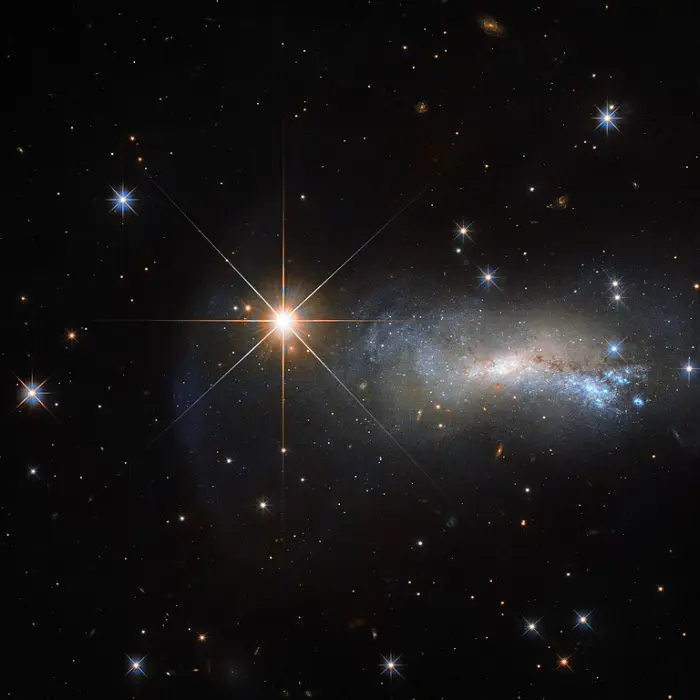
In space, being outshone is an occupational hazard. This NASA/ESA Hubble Space Telescope image captures a galaxy named NGC 7250. Despite being remarkable in its own right — it has bright bursts of star formation and recorded supernova events — it blends into the background somewhat thanks to the gloriously bright star hogging the limelight next to it. This bright object is a single and little-studied star named TYC 3203-450-1, located in the constellation of Lacerta (The Lizard), much closer than the much more distant galaxy. Only this way a normal star can outshine an entire galaxy, consisting of billions of stars. Astronomers studying distant objects call these stars “foreground stars” and they are often not very happy about them, as their bright light is contaminating the faint light from the more distant and interesting objects they actually want to study. In this case TYC 3203-450-1 million times closer than NGC 7250 which lies over 45 million light-years away from us. Would the star be the same distance as NGC 7250, it would hardly be visible in this image. Image credit: ESA/Hubble & NASA (CC BY 4.0)
IC 5217
IC 5217 is a faint planetary nebula in Lacerta. It has an apparent magnitude of 11.3 and an apparent size of about 2.5 arcseconds. It appears in the region between Alpha and Beta Lacertae. The nebula’s hot central star has the stellar classification [WC7].
IC 5217 was discovered by the Scottish astronomer Williamina Fleming in 1904.
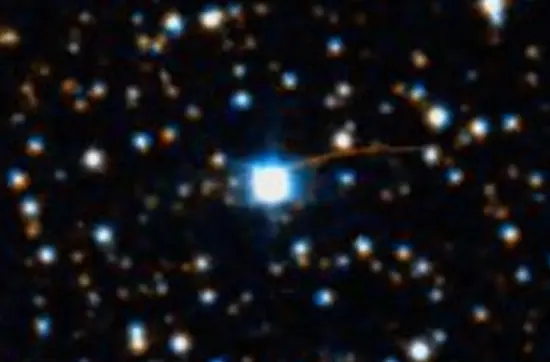
IC 5217, image: Wikisky (DSS2)
Great Lacerta Nebula (Sh2-126)
The Great Lacerta Nebula (Sharpless 2-126, LBN 437) is a vast emission nebula located approximately 1,200 light-years away. It stretches across 3 degrees, corresponding to a physical size of about 100 light-years. The nebula is very faint and best seen photographically.
The HII region is sometimes also known as the Gecko or the Scarlet Letter Nebula. Its densest part harbours young, newly formed stars. The intense ultraviolet radiation from the massive blue O-type star 10 Lacertae is responsible for exciting the nebula’s clouds of gas.
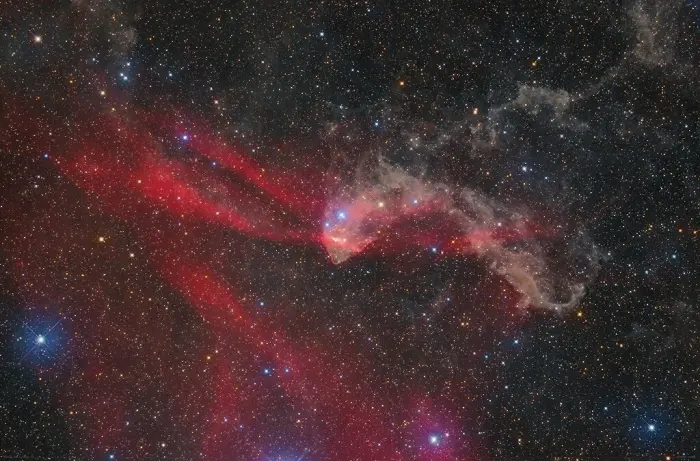
The Great Lacerta Nebula (Sh2-126), image credit: Carsten Frenzl (CC BY 2.0)
The Great Lacerta Nebula is associated with the Lacerta OB1 stellar association. It hosts a smaller reflection nebula linked with the pre-main sequence star V375 Lacertae. The Herbig Ae/Be star has the stellar classification A7Ve. It has a bipolar jet of material and is associated with Herbig-Haro objects (small patches of nebulosity in which new stars form) within the nebula.
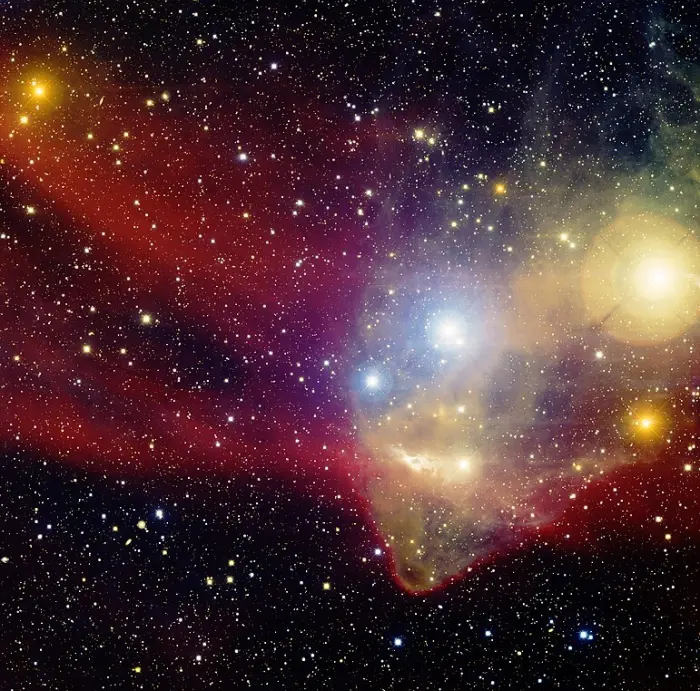
This image of Sh2-126 was obtained with the wide-field view of the Mosaic camera on the Mayall 4-meter telescope at Kitt Peak National Observatory. Informally known as the ‘star funnel’, this dark nebula is yellowish in color because it is being illuminated by several bright stars nearby. The funnel is embedded in a larger nebula of warm hydrogen gas that is glowing red. The image was generated with observations in B (blue), V (green), I (orange) and Hydrogen-Alpha (red) filters. In this image, North is up, East is to the left. Image credit: T.A. Rector (University of Alaska Anchorage) and H. Schweiker (WIYN and NOIRLab/NSF/AURA) (CC BY 4.0)
3C 449
3C 449 is a radio galaxy located 213 million light-years away. It has an apparent visual magnitude of 12.35 and an apparent size of 1.05 by 0.74 arcminutes. It is an example of a Fanaroff-Riley class I radio galaxy. These galaxies appear brighter towards the centre and typically have jets.
Observations with the Very Large Array (VLA) have revealed two symmetrical radio jets in 3C 449. The galaxy is believed to harbour an active galactic nucleus (AGN).
3C 449 is the most prominent galaxy in the galaxy cluster Zwicky 2231.2+3732. The galaxy’s halo is connected by a bridge with another galaxy that appears 37 arcseconds to the north.
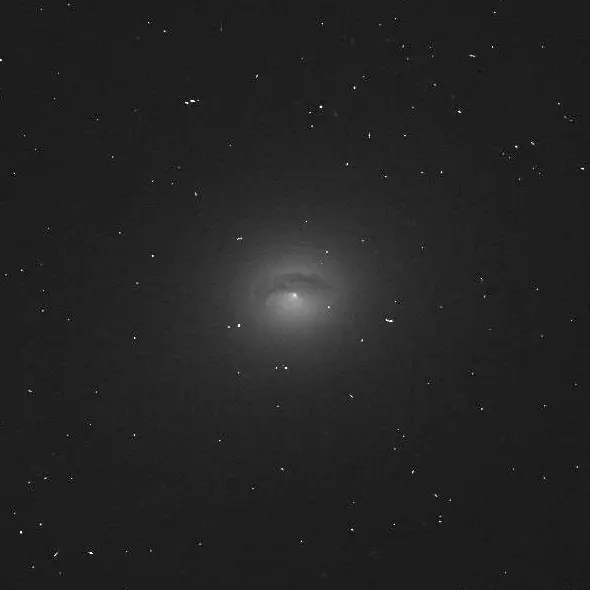
Hubble Space Telescope image of radio galaxy 3C 449 by WFPC2 instrument with the F702W Filter/Grating. Credit: NASA/ESA & Hubble (PD)
3C 452
3C 452 is an elliptical galaxy located 1.050 billion light-years away. It has an apparent visual magnitude of 16.56. It is classified as a Seyfert galaxy and a Fanaroff-Riley class 2 radio galaxy. It has an active galactic nucleus and radio lobes that extend for about 5 arcminutes.
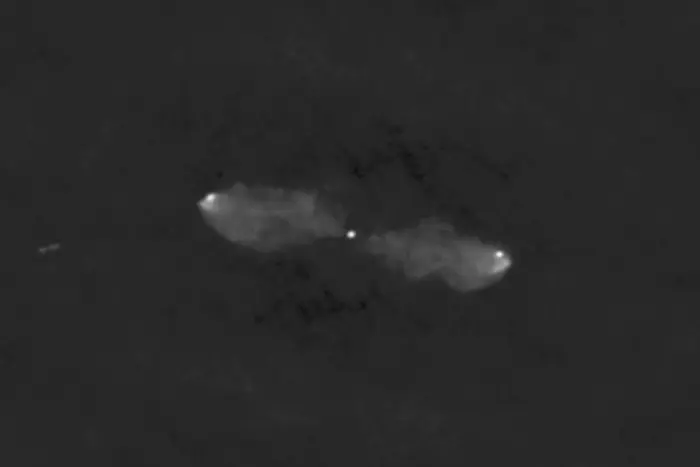
This NVAS image of 3C 452 was produced as part of the NRAO VLA Archive Survey, (c) AUI/NRAO. (CC BY 3.0)